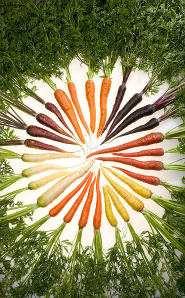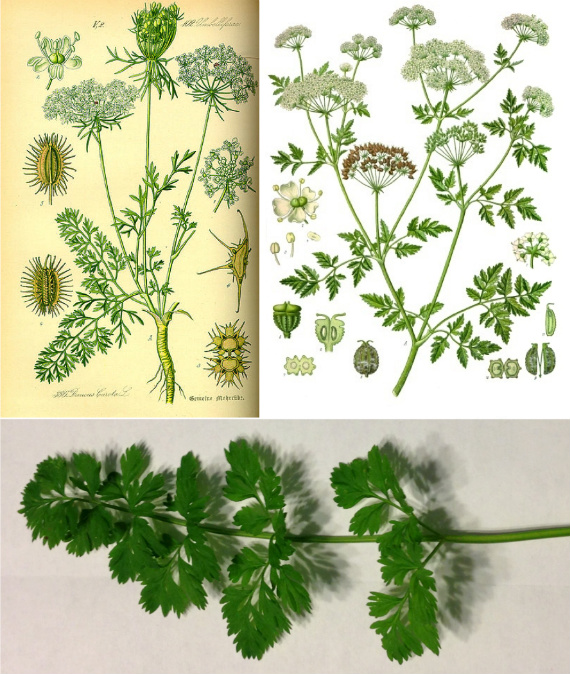 When taking a walk through Busey Woods it is fun to be able to name the types of flowers that you see, such as Queen Anne’s lace, Trillium, or trout lily. Consider how much easier it would be to survive in the wild, like Bear Grylls or Les Stroud, if you could identify edible plants. Sometimes it is hard to tell plants apart though, if they look pretty similar and grow in the same area. The carrot family is one such group. Almost every member of the carrot family has flowers with five tiny white or yellow petals that are grouped together in the shape of an umbrella, as seen in the images taken by Dr. MaryAnn Feist. They also have very similar leaves. Because there are so many members of the carrot family that are delicious — dill, fennel, cilantro, celery, parsnip, caraway, anise, and cumin, just to name a few — or deadly like poison hemlock, it is important to be able to tell these plants apart. Distinguishing carrot relatives is still quite hard, even though scientists use several different kinds of data, such as: how the plants look (which is difficult because they’re so similar in appearance), where they grow, the types of chemicals they produce, and finally, by comparing regions of their DNA.
When taking a walk through Busey Woods it is fun to be able to name the types of flowers that you see, such as Queen Anne’s lace, Trillium, or trout lily. Consider how much easier it would be to survive in the wild, like Bear Grylls or Les Stroud, if you could identify edible plants. Sometimes it is hard to tell plants apart though, if they look pretty similar and grow in the same area. The carrot family is one such group. Almost every member of the carrot family has flowers with five tiny white or yellow petals that are grouped together in the shape of an umbrella, as seen in the images taken by Dr. MaryAnn Feist. They also have very similar leaves. Because there are so many members of the carrot family that are delicious — dill, fennel, cilantro, celery, parsnip, caraway, anise, and cumin, just to name a few — or deadly like poison hemlock, it is important to be able to tell these plants apart. Distinguishing carrot relatives is still quite hard, even though scientists use several different kinds of data, such as: how the plants look (which is difficult because they’re so similar in appearance), where they grow, the types of chemicals they produce, and finally, by comparing regions of their DNA.

Remember reading about the trial of Socrates in high school? If he’d known that cilantro leaves look similar to the leaves of poison hemlock, could Plato have slipped an alternate brew to Socrates and saved him from his fate?

Above: hemlock; below: the harmless (and delicious) cilantro.
Knowing the exact relationships among similarly looking plants is important for understanding whether a species is edible or not, or even if a species contains a compound that might be useful medicinally.
For example, the drug Taxol, used to treat cancer, is found in the bark of the Pacific yew tree. Consequently, this led to its being over-harvested. Since the 90s, the species has been protected, and we almost ran out of the lifesaving medication. However, through taxonomy (the study of relationships of things), scientists learned that the Florida yew was the closest relative to the Pacific yew. So they researched this plant to see if it also had Taxol, and thankfully it too contains the compound. In this way, knowing the evolutionary history of an organism helps us to obtain additional sources of medicinal compounds. Likewise, understanding relationships can help us learn the evolution of chemicals that are tasty (or deadly), and help us know the plants that make them.
To study the evolutionary relationships of the carrot and its relatives, I spend a lot of time moving around really tiny amounts of clear liquid. This might sound boring, but in reality, every day, I make progress and see the results of my efforts. Scientists who study DNA (like myself), use similar techniques to those seen in crime shows like Bones and CSI to generate data. If you’re really curious about DNA labs, you can visit the field museum and watch their scientists do research live.
The DNA data that I generate is analyzed and put into a program that uses a mathematic model to determine the best hypothesis of relationships among the species included. The program outputs a graphic, called a phylogeny, which is a branching diagram similar to a family tree. Phylogenies show hypothetical shared ancestors and how descendants are related to one another. With this phylogeny, I can determine how the tasty plants (like dill) and toxic plants (like poison hemlock) are related to each other. Sometimes DNA is the only way to determine which species I’m dealing with. In this way, I am like Greg on CSI — a forensic scientist putting together clues to solve a puzzle, only instead of capturing criminals, I capture evolutionary history.
Using DNA data, I have helped to clarify our understanding of how carrot, dill, anise, and cilantro are related to one another. So the next time you are eating an “everything” bagel, you can be rest assured that, thanks to taxonomy research, we know those anise seeds aren’t toxic!
Written by Rhiannon Peery, Ph.D. candidate in the Department of Plant Biology at the University of Illinois.
~~*~~
Smile Politely is proud to introduce a new running series we are calling “Science Politely” that will feature the work of graduate students at the University of Illinois throughout November and December. Working in collaboration with the students in a graduate course in Integrative Biology, Science Politely is a collaboration aimed at bridging the gap between town and university, between scientist and citizen, and between research and culture








